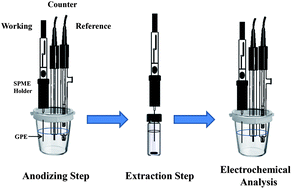This paper describes the electrochemical modification of a pencil graphite fiber used as both a solid phase microextraction fiber and a working electrode in differential pulse voltammetry (DPV). The combination of solid phase microextraction and DPV was applied as a highly selective and sensitive method for the determination of chlorpromazine. The pencil graphite fibers were electrochemically treated in phosphoric acid and sodium hydroxide solutions. Experimental parameters influencing the extraction efficiency of SPME, such as NaOH concentration, ionic strength of the sample, stirring rate, and extraction time were studied and optimized. Under the optimum conditions, analytical parameters such as linearity, precision and limit of detection were evaluated. The linear dynamic range was from 0.35 to 35 μg L−1 and the limit of detection was 0.2 μg L−1. Intra- and inter-day precision of the method was satisfactory with a relative standard deviation of 2.2 and 4.8%, respectively. The method was successfully applied for the determination of chlorpromazine in human plasma and urine.

You have access to this article
 Please wait while we load your content...
Something went wrong. Try again?
Please wait while we load your content...
Something went wrong. Try again?


 Please wait while we load your content...
Please wait while we load your content...